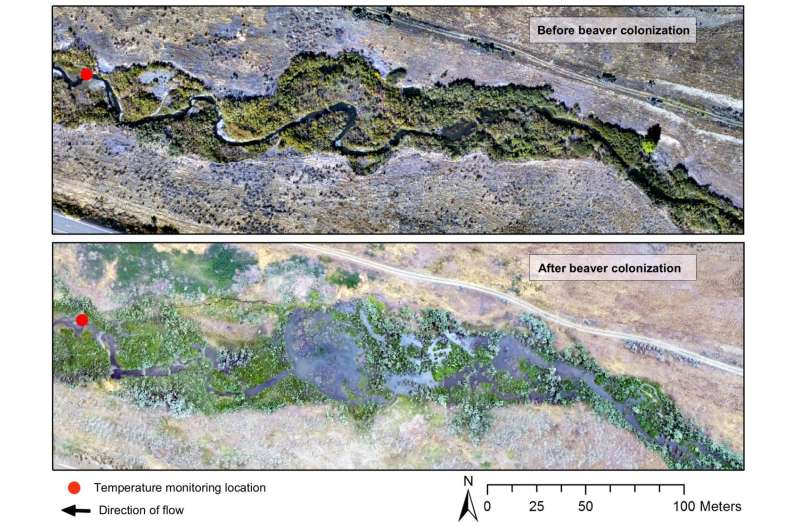Beaver dams may buffer against temperatures that threaten sensitive species

Both natural and artificial beaver dams may alter stream temperatures which may benefit temperature-sensitive salmonid species, according to a study published May 10, 2017 in the open-access journal PLOS ONE by Nicholas Weber from Eco-Logical Research, Inc., USA, and colleagues.
Beavers are ecosystem engineers, altering stream temperatures by building dams that increase surface water storage and connectivity with groundwater. Some studies suggest that the dams make water warmer and so are detrimental to salmonids, which are sensitive to temperature. Weber and colleagues tracked beaver dams and monitored water temperatures along 34 kilometers of the John Day River in Oregon over eight years. In addition, the team assessed the impact of artificial beaver dams on water temperature along four reaches of Bridge Creek.
The researchers found that beaver dams may alter stream temperatures to the benefit of salmonids. Studies suggest that juvenile steelhead salmonids in Bridge Creek experience extreme stress at about 25°C, and the researchers found that maximum daily temperatures in much of the study stream exceed this temperature for much of the summer. However, temperatures rarely exceeded 25°C after the proliferation of beaver dams, likely because they help moderate temperatures both by increasing water storage and encouraging exchange between surface water and groundwater exchange. This fits with the fact that both beavers and salmonids were once more abundant and widely distributed in North America, and suggests that beaver dams could help mitigate the thermal degradation that can threaten sensitive species.
Dr. Weber notes: "Beaver are often considered a keystone species, and their propensity to build dams plays an integral role in maintaining biodiversity and enhancing aquatic processes that benefit an array of aquatic and terrestrial organisms. Recognizing this, beaver relocation efforts and installation of structures designed to mimic the form and function of beaver dams are increasingly being used as effective and cost-efficient approaches for restoration of stream and riparian function. Despite this trend, the notion that beaver dams negatively impact stream habitat remains common, specifically the assumption that beaver dams increase summer stream temperatures to the detriment of cold-water species such as trout and salmon. However, by tracking beaver dam distributions and water temperatures throughout a high-desert, scientists have demonstrated that beaver dam can actually reduce high stream temperatures by increasing surface water storage and connectivity with cool groundwater. These results suggest that construction of artificial beaver dams and beaver relocation projects could be used to mitigate the impact of human induced thermal degradation that may threaten sensitive cold-water species."
More information: Weber N, Bouwes N, Pollock MM, Volk C, Wheaton JM, Wathen G, et al. (2017) Alteration of stream temperature by natural and artificial beaver dams. PLoS ONE 12(5): e0176313. doi.org/10.1371/journal.pone.0176313
Journal information: PLoS ONE
Provided by Public Library of Science


















